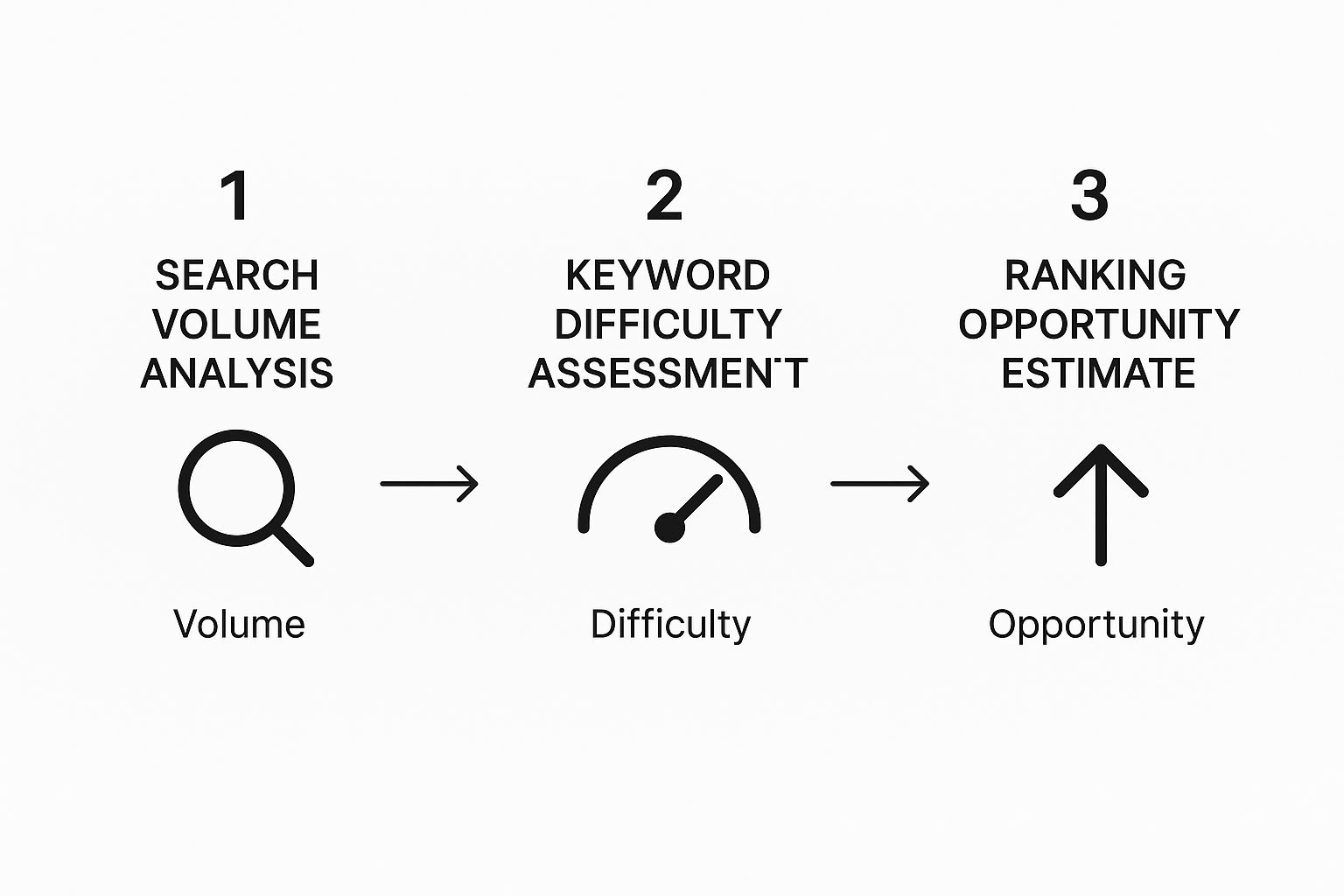keyword gap analysis, competitor analysis, seo strategy, keyword opportunities
Keyword Gap Analysis to Dominate Your Competitors
Written by LLMrefs Team • Last updated August 19, 2025
At its core, a keyword gap analysis is all about finding the valuable search terms your competitors are ranking for, but you aren't. Think of it as strategic eavesdropping—peeking at your rival's playbook to find out which plays are working for them. This moves your SEO strategy from a shot in the dark to a data-backed plan of attack.
Understanding the Value of Keyword Gaps
Imagine you run an online store selling eco-friendly cleaning supplies. You're casting your net where you think the fish are, targeting keywords like "natural all-purpose cleaner." But your competitors seem to have sonar pointing them to the biggest schools, ranking for terms like "DIY vinegar cleaning solutions" and "best non-toxic bathroom cleaner." A keyword gap analysis is your sonar. It systematically compares the keywords sending traffic to their sites against the ones sending traffic to yours.
This process shines a light on some major blind spots in your content strategy. It's not just about finding more keywords. It's about finding the specific, high-intent queries that are already proven winners for attracting your ideal audience—an audience that's currently going to your competition.
Why This Analysis Is a Game Changer
Running a keyword gap analysis is one of the quickest ways to get a leg up on the competition. The benefits are pretty clear and hit right where it counts.
- Discover Untapped Content Ideas: You'll uncover entire topic clusters and specific long-tail keywords your audience is searching for that you've completely missed. For example, the eco-friendly store might find their competitor ranks for "how to clean microfiber couch," a perfect blog post topic they hadn't considered.
- Refine Your Audience Understanding: It shows you the exact language, questions, and pain points your potential customers are typing into Google, helping you create content that truly connects.
- Gain a Competitive Advantage: By targeting the keywords your competitors already own, you can start intercepting their traffic and bringing it over to your site.
- Prioritize Your SEO Efforts: Stop guessing what to write about next. This gives you a clear, prioritized list of keywords with proven demand. Your actionable insight is a roadmap: "Create a guide on 'refillable cleaning products' because Competitor X gets 2,000 visits a month from it."
The Proven Impact on Growth
This isn't just theory; it really works. Comparing keyword sets became a foundational part of competitive SEO for a reason. In fact, some studies show that businesses conducting regular keyword gap analyses can boost their organic traffic by up to 37% in as little as six months. It just makes sense—you're finding opportunities your competitors are already cashing in on and closing the gap to claim your piece of the pie. You can find more data on how this analysis drives traffic over at NetworkSolutions.com.
Ultimately, a keyword gap analysis is a powerful strategy to find untapped opportunities and seriously improve your search rankings. If you're ready for a deep dive, there's a practical masterclass on improving search engine rankings that covers this in great detail. Of course, before you can find any gaps, you need to know which keywords you're even targeting. You can learn more about the essentials of keyword research in our guide.
How to Identify Your Real SEO Competitors
Before you can even think about doing a keyword gap analysis, you need to be crystal clear on who you're actually up against in the search results. Here’s a common trip-up: assuming your biggest business rivals are also your top SEO competitors. That assumption can derail your whole strategy.
The best way to find your true competitors? Let the SERPs be your guide.
Start with your "money" keywords—the handful of terms that perfectly describe what you sell or do. For a project management software company, this might be "Gantt chart software" or "team collaboration tools." Pop those into Google and take a hard look at which domains consistently own the top spots on page one. These are your real SEO competitors, regardless of whether you'd consider them a direct business threat.
Direct vs. Content Competitors
It’s crucial to understand that not all competitors look the same. Your analysis needs to cover both the businesses selling similar products and the wider pool of websites that simply capture your audience’s attention with great information. A solid grasp of competitor analysis for marketing is the bedrock of any good keyword strategy.
Think of it this way:
- Direct Competitors are the obvious ones. They sell the same stuff to the same people. It’s a head-to-head match.
- Content Competitors are a bit sneakier. They aren’t selling your product, but they are attracting your ideal customer by answering their questions with blogs, guides, or videos.
Let’s say you run a local meal kit delivery service. Your first instinct is to look at other meal kit companies in your city. But search for "easy weeknight dinner recipes," and you'll likely find giants like Allrecipes or Food Network dominating the results. They're not selling meal kits, but they're winning the attention of your exact target audience.
Ignoring content competitors is one of the biggest mistakes you can make. They are successfully capturing your audience at the top of the funnel with informational content, which is a massive opportunity you could be missing.

Identifying Your True SEO Competitors
To make this practical, you need to categorize the players in your space. A comprehensive competitor list includes a mix of businesses and publishers, giving you a full 360-degree view of the search landscape.
This table breaks down the different types of competitors to look for, ensuring your analysis is both thorough and effective.
| Competitor Type | What They Do | Example (For a 'Meal Kit Delivery' Service) |
|---|---|---|
| Direct Competitor | Sells the same type of product to the same audience. | Another meal kit delivery company operating in the same city. |
| Indirect Competitor | Sells a different product that solves the same problem. | A local grocery store that offers home delivery for ingredients. |
| Content Competitor | Creates content that attracts your target audience. | A popular food blog that publishes weekly dinner recipes and meal plans. |
Mapping out these different rivals is a non-negotiable first step. When you include this full spectrum in your keyword gap analysis, you uncover a much wider, richer set of opportunities. You'll find everything from high-intent commercial keywords to top-of-funnel informational queries, giving you the raw material for a truly dominant content strategy.
Performing Your Keyword Gap Analysis Step by Step
Alright, you've identified your true SEO competitors. Now it's time to get your hands dirty and dig into the data to unearth those game-changing keyword opportunities. Let's walk through this process together. To keep things grounded, we'll use a hypothetical sustainable fashion brand as our example every step of the way.
The entire keyword gap analysis process lives and dies by the quality of your SEO tool. These platforms are the workhorses, pulling in massive amounts of keyword data and making sense of it all. Choosing the right one is a big first step, and you might find yourself comparing tools like Semrush vs Ahrefs for keyword research. Other great options include Moz and SE Ranking, but for our walkthrough, we'll follow a workflow that's pretty standard across all the major players.
Step 1: Enter Your Domain and Competitors
First things first, fire up your chosen SEO platform and find its keyword gap or competitive analysis feature. You'll usually land on a straightforward interface asking for a few domain names.
Start with your own. Let's pretend our sustainable fashion brand is ecothread.com. Then, plug in the domains of the competitors you just found. You might add a direct rival like patagonia.com and a big-time content competitor, maybe the fashion section of thegoodtrade.com. Most tools will let you pop in three to five competitors at once.
Once you hit that "Compare" or "Analyze" button, the tool gets to work, cross-referencing all the keyword profiles and spitting out a detailed report. This report is the foundation for everything that follows.
Step 2: Understand the Keyword Categories
The first results page can feel a bit like drinking from a firehose, often showing thousands of keywords. The trick is to know how the tool sorts them. It usually boils down to a few key buckets.
- Missing Keywords: This is where the gold is. These are the terms your competitors rank for—often within the top 100 results—but your site is completely invisible for. It's a ready-made list of your biggest content gaps. Actionable Insight: If a competitor ranks for "sustainable winter coats" and you don't, that's a new product category page or blog post you need to create.
- Weak Keywords: Think of these as low-hanging fruit. "Weak" keywords are terms where you and your competitors both show up, but they're leaving you in the dust with much higher rankings. Actionable Insight: If you rank #15 for "organic cotton t-shirt" and a competitor is #3, you need to optimize your existing page for that term immediately.
- Strong Keywords: This is your home turf—the keywords where you're already outranking the competition. It's always good to know where you're winning.
- Shared Keywords: This is a broad category that includes any keyword you and at least one competitor both rank for, no matter the position.
For a true gap analysis, you’ll want to zoom in on the Missing and Weak categories. That's where you'll find the most immediate and impactful opportunities for growth.
Step 3: Filter and Refine Your Results
Now it's time to slice and dice that data. A raw keyword list is messy, often cluttered with your competitor's branded terms, irrelevant queries, or keywords with virtually no one searching for them. Filtering is how you turn that data dump into a clean, actionable shortlist.
Here are the essential filters to apply right away:
- Position: Tell the tool to only show you keywords where your competitors are ranking in the top 10 or 20. This focuses your attention on terms that are actually driving real, valuable traffic for them.
- Keyword Difficulty (KD): Set a realistic ceiling for KD. If your site is relatively new, you might cap it at under 40 to find keywords you actually have a shot at ranking for.
- Volume: Set a minimum monthly search volume—say, 100 or more—to weed out the queries that almost no one is searching for.
Focusing your initial analysis on keywords with moderate volume and achievable difficulty is a strategic move. It's better to rank on page one for a keyword with 500 monthly searches than to be stuck on page ten for a term with 50,000 searches.
This process of filtering has become a cornerstone of modern SEO. In fact, by 2024, it's estimated that over 70% of successful digital marketing campaigns lean heavily on keyword gap analysis. Targeting keywords with monthly search volumes between 10,000 and 100,000 and moderate difficulty scores (30-50) often hits the sweet spot between reach and achievability. Some campaigns have even seen a 20-40% jump in rankings in just a few months by following this strategy.
Step 4: Pinpoint Your Best Opportunities
With your list filtered, it's finally a manageable size. Now you can do the human part: manually review the keywords and pick your top targets.
Back to our sustainable fashion brand, ecothread.com. A look at the "Missing" keywords might show that thegoodtrade.com is ranking high for "best non toxic bedding" and "organic cotton socks." These are perfect informational keywords that pull in their ideal audience. Meanwhile, the "Weak" keywords might reveal that patagonia.com is crushing them for "recycled fleece jacket," signaling that ecothread.com needs to go back and optimize its own product page for that term.
This chart breaks down a simple way to evaluate each potential keyword, moving from its search volume to its difficulty, and finally, its potential for your site to rank.

By sticking to this workflow, you can methodically sift through all that data and pull out the keywords that will give you the biggest bang for your buck.
The last thing to do is export this polished list of high-potential keywords into a spreadsheet. This document isn't just a list; it's the blueprint for your entire content plan, ready for you to prioritize and execute.
How To Prioritize Your Keyword Opportunities
So, your keyword gap analysis just dumped a massive spreadsheet on your desk. Hundreds, maybe even thousands, of potential keywords are staring back at you. It’s easy to feel overwhelmed, but here's the secret: you’re not supposed to target everything. The real skill is in cutting through the noise to find the gems—the opportunities with the highest potential impact.

This is where smart prioritization comes in. Instead of just picking keywords at random, you need a strategic framework to score and rank them. This process transforms that raw data into a focused, actionable plan, ensuring your content efforts are aimed at keywords that will actually move the needle for your business.
The Three Pillars of Keyword Prioritization
To build a solid scoring system, I always lean on three core pillars. Think of each one as a filter that helps you gauge a keyword’s true value against your specific goals.
Business Relevance: How closely does this keyword align with what you actually sell? Is the searcher a potential customer or just a curious browser? Practical Example: For a vegan protein powder company, the keyword "plant-based meal prep" is highly relevant (score 5/5). "Benefits of weightlifting" is less relevant (score 2/5).
Search Volume: Simply put, how many people are looking for this term each month? While bigger is often better, don't sleep on lower-volume keywords. These can be incredibly valuable if they have high relevance, driving highly qualified traffic that’s ready to convert.
Ranking Difficulty: How tough will it be to crack the first page for this keyword? This metric, often a score out of 100, helps you find a realistic place to start. Targeting terms with a lower Keyword Difficulty (KD) can deliver quicker wins and build momentum.
These three pillars are like the legs of a stool. If one is shaky—for example, a keyword has massive volume but zero relevance to your business—the whole opportunity is unstable. It’s just not worth pursuing. A balanced approach is what you’re after.
Understanding Search Intent: The Deciding Factor
Beyond the raw numbers, the single most critical element to get right is search intent. This is the "why" behind a user's query. Honestly, understanding intent is what separates a good SEO strategy from a great one. It tells you exactly what kind of content you need to create to make that searcher happy.
Simply matching a keyword isn't enough. You must match the intent behind it. If a user wants a comparison and you give them a product page, you've missed the mark, and your content is unlikely to rank.
Generally, search intent breaks down into four main types:
- Informational: The user wants to learn something. (e.g., "what is sustainable cotton") - Actionable Insight: Create a blog post or guide.
- Navigational: The user is trying to find a specific website. (e.g., "Patagonia login") - Actionable Insight: Usually ignore these unless it's your brand.
- Commercial: The user is researching before a potential purchase. (e.g., "best recycled fleece jackets") - Actionable Insight: Create a comparison guide or a "best of" list.
- Transactional: The user is ready to pull out their wallet. (e.g., "buy patagonia jacket online") - Actionable Insight: Optimize a product or category page.
When you prioritize keywords, filtering by intent is a game-changer. This focus helps ensure you're creating content that meets—and exceeds—user expectations. If you're curious about how technology is making this easier, you can learn more about the role of AI in search engine optimization and its ability to decipher user intent.
Creating a Practical Scoring System
Alright, let's turn this framework into a simple, practical scoring system. You can easily do this in your spreadsheet. Just create a new column called "Priority Score" and start evaluating each keyword.
Here’s a quick table you can adapt. It’s designed to help you methodically score each opportunity from your gap analysis, forcing you to consider all the key factors before committing resources.
Keyword Opportunity Prioritization Matrix
| Keyword | Monthly Volume | Ranking Difficulty | Business Relevance (1-5) | Primary Intent | Priority Score |
|---|---|---|---|---|---|
| organic cotton vs regular cotton | 1,200 | 35 | 5 | Informational | High |
| eco-friendly t-shirt brands | 800 | 45 | 5 | Commercial | High |
| what is fast fashion | 5,000 | 60 | 3 | Informational | Medium |
| cheap cotton socks | 2,500 | 70 | 1 | Transactional | Low |
By applying this simple scoring method, you can quickly sort your massive list of opportunities from highest to lowest impact. Suddenly, that intimidating spreadsheet becomes a clear and logical content roadmap.
Turning Your Analysis into a Winning Content Plan
Finding those keyword gaps is a great start—it’s like striking oil. But just finding the resource isn't enough; the real value comes from extracting and refining it. Your prioritized list of keywords is the raw material. Now comes the fun part: turning that data into a smart, actionable content plan that actually moves the needle on your SEO.

This is the moment your keyword gap analysis transforms from a spreadsheet into a strategic roadmap. It tells you exactly what content to create, what to refresh, and how to structure it all to build your brand’s authority.
Capitalizing on Your Findings
As you look at your prioritized keyword list, you'll see that your opportunities naturally fall into a few different buckets. Each type of gap points to a specific kind of action, which helps you build a balanced and effective content calendar.
Here are the three main plays your analysis will set you up for:
- Create New Content: This is your move for "Missing" informational keywords where you have zero presence. Actionable Insight: If you're missing "how to compost at home" and your competitor ranks #1, your action is to create the most comprehensive guide on the topic on the internet.
- Update Existing Content: For "Weak" keywords—the ones where competitors are eating your lunch—it’s often smarter to improve what you’ve already got. Actionable Insight: You rank #12 for "best eco-friendly laundry detergent." Your action is to update your existing blog post with a 2024 product comparison table, add user reviews, and build internal links to it.
- Build Topic Clusters: A keyword gap analysis often shines a light on entire topic areas where your competitors are just dominant. Instead of playing whack-a-mole with one-off articles, think bigger. Actionable Insight: You see competitor gaps for "sustainable living," "zero waste kitchen," and "eco-friendly bathroom." Your action is to plan a "Sustainable Home" pillar page and create supporting articles for each sub-topic.
Taking action on the data is what separates a successful SEO strategy from one that just collects dust. A 2023 industry study found that websites performing quarterly keyword gap analyses grew organic traffic by an average of 33%. Those that didn't? They only grew by 10%.
That's a massive difference, and it really drives home the importance of a consistent strategy. Companies that regularly act on these insights don't just see more traffic; they report much stronger lead generation and conversion rates. You can dig into how regular keyword gap analysis fuels growth at AIOSEO.
A Practical Example in Action
Let's go back to our sustainable fashion brand. After sifting through their data, they spotted a huge opportunity around the keyword "ethical denim." Their analysis showed a couple of competitors ranking all over page one for related terms, while their own site barely had a whisper about it.
Here’s how they could spin that one insight into a full-blown content plan:
- New Pillar Page: They could start by creating "The Ultimate Guide to Ethical and Sustainable Denim." This piece would target that core keyword and act as the central hub for everything they have to say on the topic.
- Supporting Blog Posts: Next, they'd brainstorm and write several related articles that link back to that pillar page. Think long-tail keywords like "How to Tell if Your Jeans are Ethically Made" or "Best Sustainable Denim Brands."
- Existing Content Update: They also saw they were ranking poorly for "recycled denim jacket." Instead of writing a whole new post, they could simply beef up their existing product category page for jackets. Adding a detailed section about their recycled denim process and materials would make that page much stronger for the target keyword.
This kind of strategic approach does way more than just plug a single keyword gap. It systematically builds topical authority. By weaving an interconnected web of content around a key theme, you're sending a powerful signal to search engines that you are the definitive resource on the subject. And that’s how a simple analysis evolves into a long-term, traffic-winning strategy.
Common Questions About Keyword Gap Analysis
Once you've run a keyword gap analysis a time or two, you'll find that certain questions naturally start to come up. Let's dig into some of the most common ones. Getting these details right is what turns a good analysis into a great one.
Think of it like learning any new skill. The first time, you just follow the steps. But by the third or fourth go-around, you start asking the "why" and "how often" questions that really lead to mastery.
How Often Should I Do a Keyword Gap Analysis?
The short answer is: a keyword gap analysis is not a one-and-done task. Your market, your customers, and your competitors are always on the move. New trends pop up, search habits change, and your rivals are always publishing new content.
For most businesses, running a full-blown analysis quarterly is the sweet spot. It’s frequent enough to catch important shifts without becoming a massive time sink. Of course, if you're in a super fast-paced industry or a high-growth startup, you might want to do a monthly check-in just to stay ahead of the curve.
Think of your keyword gap analysis as a regular health check-up for your SEO strategy. It helps you diagnose what's weak, spot new opportunities, and make sure you stay competitive over the long haul.
A quarterly review also gives you enough breathing room to actually act on the insights from your last analysis, measure the results, and then start the cycle over with fresh data. This creates a powerful, continuous loop of improvement.
Can I Do This Without Paid Tools?
Absolutely. While fancy SEO platforms like Semrush or Ahrefs make this process incredibly fast and efficient, you can definitely pull off a basic keyword gap analysis for free. It just takes a bit more manual labor and some good old-fashioned detective work.
You can actually get pretty far just using Google itself.
- Manual SERP Analysis: Open an incognito window and search for your main keywords. Who's ranking on page one? Make a list. Then, use search operators like
site:competitordomain.com "your topic"to see what kind of content they've already created around that subject. - Google Keyword Planner: It's built for Google Ads, but you can plug a competitor's website into it and see what keyword ideas it spits out. This can be a great way to find terms you hadn't even thought of.
- "People Also Ask" & "Related Searches": These little boxes on the search results page are pure gold. They tell you exactly what other questions and topics are on your audience's mind, revealing long-tail keywords your competitors might be targeting.
This manual route won’t give you the clean, sortable data that a paid tool does, but it will absolutely help you spot the most obvious gaps in your content. It’s a fantastic starting point if you're on a tight budget.
What Are the Biggest Mistakes to Avoid?
Sometimes, knowing what not to do is just as important as knowing what to do. A few common blunders can easily send your analysis off the rails, causing you to waste a ton of time on the wrong keywords.
Here are the big mistakes to sidestep:
- Choosing the Wrong Competitors: We've talked about this, but it's worth repeating. Your direct business rival isn't always your top SEO competitor. If you only look at them, you'll completely miss the blogs, niche publishers, and forums that are actually winning your audience's attention in search.
- Misinterpreting Search Intent: This is probably the single biggest mistake you can make. You find a great keyword gap for "best running shoes for flat feet" (a commercial term) but then you write a broad, informational post about foot anatomy. It's just not going to rank. You have to match your content type to what the searcher is actually trying to do.
- Ignoring Keyword Difficulty: It’s so tempting to go after those juicy, high-volume keywords. But if the difficulty score is through the roof and you're a smaller site, you're just setting yourself up for failure. Prioritize the achievable wins first to build authority and momentum.
- Letting the Data Collect Dust: The most tragic mistake of all is doing a brilliant analysis… and then doing nothing with it. An insights-packed spreadsheet is worthless until you turn it into an actual content plan that gets published.
Steering clear of these traps will make sure the effort you put into your analysis actually pays off. Modern tools can also help bridge these gaps; for example, you can learn more about using ChatGPT for SEO to brainstorm content ideas based on your findings.
Ready to uncover how you and your competitors stack up in the new era of AI search? LLMrefs provides real-time tracking of brand mentions and citations across AI answer engines like ChatGPT, Gemini, and Perplexity. Identify your competitor gaps in generative AI and build a winning GEO strategy. Get started for free at https://llmrefs.com.
Related Posts

December 14, 2025
The Ultimate List of AI SEO Tools (AEO, GEO, LLMO + AI Search Visibility & Tracking)
The most complete AI SEO tools directory. 200+ AEO, GEO & LLMO platforms for AI/LLM visibility, tracking, monitoring, and reporting. Updated Dec 2025.

December 13, 2025
How ChatGPT memory works, reverse engineered
Reverse engineering ChatGPT Memories reveals it does not use RAG or vector databases. It uses: metadata, facts, conversation summaries, and a sliding window.

December 10, 2025
33 key terms you need to know for AI SEO in 2025
Comprehensive glossary of 33 essential terms for AI SEO in 2025. From GEO and AEO to citations and fan-out queries, learn the vocabulary that defines modern search optimization.

December 8, 2025
AI assistants are not search engines
We analyzed 4.5M ChatGPT conversations. Two thirds have zero commercial intent. People use AI to think, not to shop. Here is what that means for your content strategy.